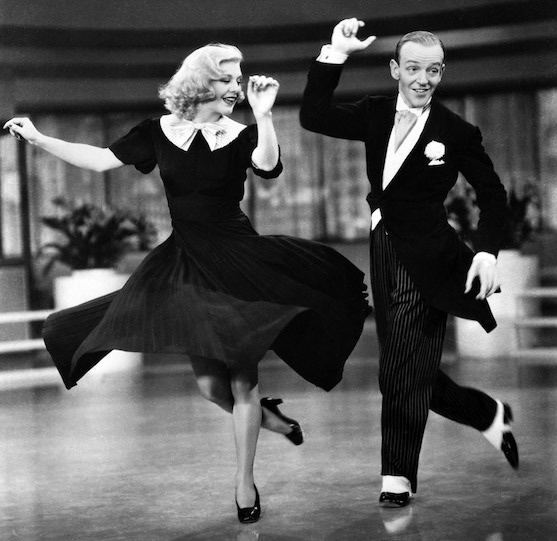The Evolution Of Dance

An example of dancing from the play “Swing Time.”
April 12, 2021
Your go-to party moves have probably drastically changed throughout your time on and off the dance floor. From “The Charleston” to “Dabbing,” dance moves have had an enormous influence on youth cultures and have kept us on our toes with the trendiest moves.
To see just how much busting a move has changed, let’s go all the way back to the roaring 20s.
Swing dance was inspired by a revolution of jazz music that kept audiences on the dance floor. Swing dance came in many styles including the Balboa, Lindy Hop, the Charleston and Collegiate Shag.
A blog, posted by Arthur Murray of New Jersey, sums up Swing Dance perfectly. “Swing dancing is a popular social dance that is often characterized by lifts, spins and flips. It’s generally upbeat, lively and a lot of fun to watch—and to dance! Like most dance styles, there are variations of the dance.”
“It includes some basic steps and then dancers have creative freedom to make it their own.” If you are interested in becoming a “swinger,” Dance of Murfreesboro, Nashville Swing Dance Foundation and Nashville Ballroom & Company all offer private and group lessons to those interested!
Moonwalk
When initially thinking of the moonwalk, you may think of Michael Jackson. Jackson might have perfected the move, but the King of Pop actually did not invent the move!
Despite his debut of the move at Motown 25 in 1983, the moonwalk roots back to Cab Calloway in 1932.
Locking, Popping, and Robot-ing
From the 60s to modern times, you can see just how much people have become more creative and willing to try new things as dancing gained major popularity.
The Robot is the best dance move for those who aren’t as confident in their dancing abilities. The Robot doesn’t require coordination, so it’s suited for those who love to just have fun.
On the other hand, popping, which is different from locking, is one of the earliest forms of funk. Popping, specifically, is the dance in which the body pops or “hits” on certain motions. Popping is often mixed with other street and funk styles to add variation to a performance.
Locking is similar to the hip hop variations you do today. Pop-locking is done with locking, waving, floating or another funk style. These moves prove that some can stand the test of time and transcend cultural boundaries.
Each of these types of dance includes isolations, which is when you keep the rest of your body still while you separate and move a part of it.
The 70s are known for the music, dance clubs and the big surge of Disco dancing. Dance fads including the Bump, the Hustle, YMCA, Funky Chicken Dance and The Lawnmower all became very popular.
Disco is a genre of music that was most well-liked from the 1970s to early 80s. People would mostly dance to disco music at disco clubs. This music had a strong beat meant for dancing and included elements of soul, funk and Latin music.
“The Carlton” was first seen on the hit TV show “The Fresh Prince of Bel-Air.” Although lead actor Will Smith was an impressive hip-hop dancer, the iconic dance move was performed by co-star Alfonso Ribeiro, who portrayed Carlton Banks.
The move requires you to sway side to side and swing your arms. To get a better understanding of what exactly this timeless move looks like check out the link.
I am sure you’ve heard of the infamous Macarena. The original version of the Macarena debuted in 1993, but in 1995 the English language version was released, sparking the most popular one-hit-wonder to ever hit the American music industry.
The dance itself is performed everywhere from weddings to parties; any place where people dance can turn into the Macarena.
In 2008, Dougie grew in popularity as the newest hip-hop craze. The group Cali Swag District released the song “Teach Me How To Dougie.” To go along with the song, fans learned the slicking-the-hair-back move.
The Whip and Nae Nae is a hip-hop dance that involves placing one arm in the air and swaying from side to side.
In 2015, American rapper Sliento released his single “Watch Me (Whip/Nae Nae).” The dance move and song began gaining widespread popularity on mainstream platforms such as Vine, Twitter and Instagram.
The Floss is a popular dance move in which you swing your hips in the opposite direction to your arms — which are in two fists. After swinging your arms to one side, keeping them straight, you then move one arm behind your back, and bring it back out in front.
The well-known dance was invented by “The Backpack Kid” also known as 16-year-old Russell Horning.
“Dabbing” first emerged from the Atlanta hip-hop scene due to the popularity of the music video “Look At My Dab” by a group called Migos. Teens around the world quickly took part in this new fad and a trend was born.
Cam Newton is also credited for the newfound popularity of the “Dab.” He first dabbed in November of 2015 in a match against the Tennessee Titans to celebrate every time he scored a touchdown.
In late 2018- early 2019, the new phenomenon of “hitting the whoa” became the trendiest move among teens. This new fad is when a dancer makes a quick, small circular motion with their fists and leans into a freeze position.
The move gained popularity on mainstream apps like TikTok when it was presented in dances.
As a four-year veteran of the CCHS Raiderettes, I can say that dance moves and interesting choreography are what make a dance appealing. Modern day dance would be nothing without the evolution of dance moves and creativity.



